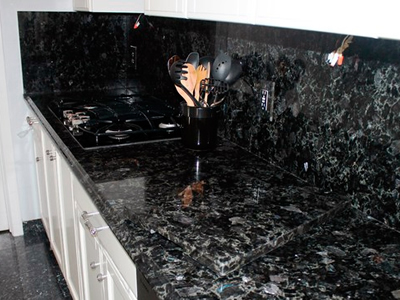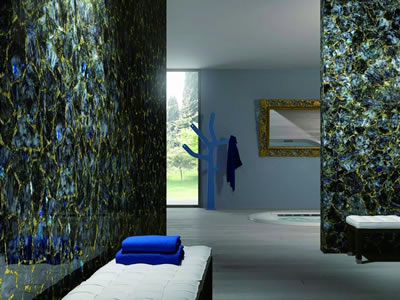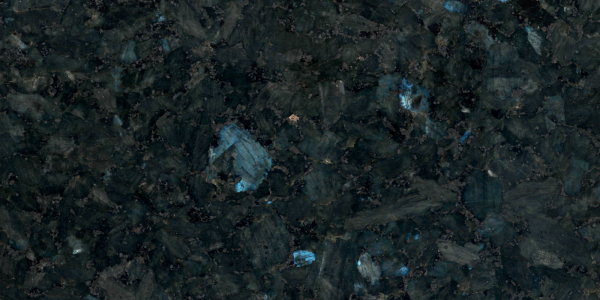Labradorite Stone Catalog
 Labradorite is a type of rock with the rare property of iridization, an internal iridescent glow (reminiscent of the play of light in a drop of gasoline or the pearlescent sheen inside a clam shell). The color, glittering from light-blue to deep purple, and even green, greatly enhances the aesthetic value of the rock. This optical property gives the stone volume and richness of texture. The stone seems to come to life and change under the influence of different lighting sources.
Labradorite is a type of rock with the rare property of iridization, an internal iridescent glow (reminiscent of the play of light in a drop of gasoline or the pearlescent sheen inside a clam shell). The color, glittering from light-blue to deep purple, and even green, greatly enhances the aesthetic value of the rock. This optical property gives the stone volume and richness of texture. The stone seems to come to life and change under the influence of different lighting sources.
The combination of strength characteristics (labradorite is even stronger than granite) and aesthetic effect makes this stone very attractive for designers and architects. It has also been attributed mystical properties, due to its mineral radiance.
In terms of properties, labradorite is very close to granite with its characteristic granularity and high strength. Solid wood can be used as a finishing material with limited structural strength. However, if improperly processed, the stone can crack and become unstable as well as become more susceptible to damage from cold.
Labradorite characteristics:
- hardness on the Mohs scale - from 6 to 6.5
- compressive strength - about 230 MPa;
- bending strength - about 21 MPa;
- wear resistance (abrasion) - 0.50 g / cm2;
- resistance to weathering (water absorption) - 0.21%;
Characteristics may vary slightly depending on the field and the choice of processing technology. Of great importance is not only the color scale, but also the state of the rock mass at the place of occurrence. Most valued is material from a partially enclosed outlet where it has not been eroded.
Labradorite is used to make:
- smooth stone countertops;
- suitable for kitchen furniture and massive cabinet products;
- tiles for interior decoration and, in some cases, for exterior decoration of parts of walls and elements of architectural decoration of a building -thin plates of mineral that can be applied to the surface of furniture, giving objects a spectacular appearance;
- massive products with labradorite inclusions for landscape design;
- small and medium-sized ornaments, mosaics and decorative elements made of a whole crystal;
Contents of the article:
- What is labradorite
- Properties of Labradorite
- Labradorite Composition
- Mining of Labradorite Labradorite
- Usage Labradorite in architecture and design
WHAT IS LABRADORITE
 In terms of geology and chemistry, labradorite is a type of granite with a coarse-grained structure and the inclusion of a large number of labradorite crystals of different colors. Depending on the origin and the number of inclusions, the stone may have different color variations. The origin of a particular material can be identified by its characteristic color set, which is typical of each field. The effect of the color variety is created by the crystals and slices of plaxiosis or labradorite, the main component of the stone.
In terms of geology and chemistry, labradorite is a type of granite with a coarse-grained structure and the inclusion of a large number of labradorite crystals of different colors. Depending on the origin and the number of inclusions, the stone may have different color variations. The origin of a particular material can be identified by its characteristic color set, which is typical of each field. The effect of the color variety is created by the crystals and slices of plaxiosis or labradorite, the main component of the stone.
Labrador Mineral
The origin of this stone is volcanic; it is a class of magmatic rock that is formed during volcanic activity by the egress of red-hot material. Subsequently, the mass solidifies, acquires strength and retains its structure for a long time under the sediment. Before processing, the stone does not give that much of an impression, as it looks almost homogeneous. In the legends of some peoples (mainly American Indians), it is believed that the Labrador stone contains the northern lights. In general, it looks very similar.
Northern Lights Labrador
The full aesthetic effect occurs when the surface is polished, the plaxiogloss crystals are "cut" and the inclusions begin to reflect light. If the material is chosen and treated correctly, the iridization effect is so strong that the stone appears to glow from within, shimmering. When polished, it looks like a complex surface with a characteristic play of colors.
LABRADORITE PROPERTIES
 Labradorite is very close to granite in terms of its properties with its characteristic granularity and high strength. The solid can be used as a finishing material with limited structural strength, but the monolith may crack and lose its resistance to frost if improperly processed. In terms of construction, finishing problems, and the manufacture of interior elements, a number of characteristics of labradorite are valued:
Labradorite is very close to granite in terms of its properties with its characteristic granularity and high strength. The solid can be used as a finishing material with limited structural strength, but the monolith may crack and lose its resistance to frost if improperly processed. In terms of construction, finishing problems, and the manufacture of interior elements, a number of characteristics of labradorite are valued:
- Mohs hardness - 6, to 6.5
- Compressive strength - about 230 MPa;
- bending strength - about 21 MPa;
- wear resistance (abrasion resistance) - 0.50 g/cm2;
- resistance to atmospheric phenomena (water absorption) - 0.21%.
Characteristics may vary slightly depending on the field and the choice of processing technology. Of great importance is not only the color range, but also the state of the rock massif at the site. The most valuable material is the one that is mined in a partially closed outcrop, where it has not been subjected to erosion.
LABRADORITE COMPOSITION
The chemical and mineral composition of labradorite may vary considerably, since the rock is formed during volcanic activity and is a set of solidified phenocrysts. To give an idea of its structure and main components, we can give approximate values:
- Labrador (plaxioglase) - 50 to 70 %;
- Quartz, pyroxene, feldspar, and other minor inclusions
- The chemical composition looks like this: (Na,Ca)(Al,Si)4O8 with Na (30-50%) and Ca (70-50%). When comparing with granite and other igneous rocks, there is a relative proximity, a relative coincidence of the set of components.
- The pure labradorite (plaksioglaz) with its lamellar structure is quite rare, it is mainly surrounded by a dense welded massif of crystalline inclusions. The color gamut is varied:
- solar labrador (only in USA) - a golden hue of inclusions, a characteristic rich yellow shimmer;
- black lunar labrador - deep dark combination of blue mass with bluish inclusions;
- red-brown labrador - "Bullseye" with a characteristic light asterism streak that changes direction when turning a piece of stone;
- Green Labrador, Cat's Eye, is a quartz with a vertical band of light reflection
- Blue-green labrador (tavusite) from India is called "Peacock's Feather";
- Reddish-copper - aventurine with a shimmering sheen due to the mixture of copper and magnetite;
Spectrolite is a rare and valuable variety with a lot of iridescent components and a "sparkling" play of light.
EXTRACTION OF LABRADORITE
At the deposits, labradorite is usually found as an inclusion in basalt massifs, where it occupies voids and gas cavities formed during eruptions. Depending on the location and specific conditions of formation, it may be a large single crystal of plaxiodorite or a cluster of crystals. The size of the crystal usually does not exceed half a meter in length. In the vast majority of cases, labradorite is accessible as a mass of inclusions in granite or basalt.
Labradorite quarry in Larvik, Norway.
When deposits are found, they are classified by vertical section:
- laccolite - a depression or pit;
- lopolite - a plate-like inclusion
- dyke or rod - a wall or column.
A large-crystal mass may split when mined. A small or medium-sized monocrystal is amenable to extraction from the cavity, but is destroyed if the massif has been undermined and split into pieces during the first stage. Processing with a special tool reveals the edges of the lamellar layers, which reflect light and form a pattern by superimposing light waves of different lengths.
Deposits of labradorite are located all over the world, including in Europe (Labrador Antique in Norway), in Ukraine (Volga Blue).
USE OF LABRADORITE
 Depending on its structure (monocrystal, cluster of crystals), labradorite can be used to make:
Depending on its structure (monocrystal, cluster of crystals), labradorite can be used to make:
- smooth stone countertops suitable for kitchen furniture, solid cabinet pieces;
- Tiles for finishing rooms and in some cases for the external decoration of parts of walls, elements of architectural ornamentation of buildings;
- Thin slabs of the mineral, which can be applied and glued on the surface of furniture, giving the objects a solid and prestigious appearance;
- solid pieces with labradorite inclusions for landscape design;
- ornaments, mosaics and decorations of small and medium size made of whole plaxioglossum crystals.
- Shimmering Labradorite shell
The stone is not classified as precious or semi-precious and is considered affordable for business use, although some labradorite is gradually increasing in value as demand increases.
LABRADORITE IN ARCHITECTURE AND DESIGN
 Interior solutions made of labradorite can be divided into several groups, depending on the condition in which the stone was taken from the location. It looks very beautiful to finish furniture and walls with tiles, if you managed to find a few of the same type of medium crystals for sawing.
Interior solutions made of labradorite can be divided into several groups, depending on the condition in which the stone was taken from the location. It looks very beautiful to finish furniture and walls with tiles, if you managed to find a few of the same type of medium crystals for sawing.
Emerald pearl Labradorite countertop.
Shimmering or playing with shades of color, the surface of labradorite creates an impression of mystery, depth and volume, sunlight, solid warm and dark surroundings.
Blue pearl marina Labradorite countertop.
Larger slabs are finished with a cluster of crystals which are sawn and polished to resemble a granite slab, with grainy specks of different colors or shades.
These solutions can be used in large rooms of the palace and castle type, in mansions, where a combination of light effect and height of the ceilings creates an interesting picture of a rich decoration. With a skilful selection of lighting, you can achieve the effect of changing the color of walls and individual interior elements depending on the time of day.

Maryland: 1954 Halethorpe Farms Rd #500, Halethorpe, MD 21227
Florida: 6850 Lyons Technology Cir, Coconut Creek, FL 33073
New Jersey: 502 Jersey Ave, New Brunswick, NJ 08901

Services
Stone catalog
Where we work
Follow Us
Recent Articles
- The Price of Black Quartz Countertops: A Comprehensive Guide
- Choosing Between Quartz and Quartzite Countertops in 2024
- Which Countertop to Choose in 2024: Quartz or Quartzite?
- Buying Quartzite in New York: A Comprehensive Guide
- Quartz in New York: A Comprehensive Guide
- Buy Quartz in New Brunswick: The Ultimate Guide




